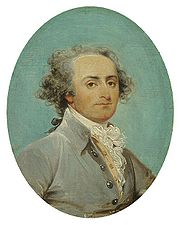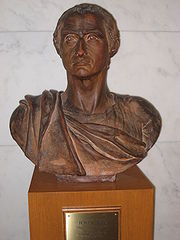
Giuseppe Ceracchi
Encyclopedia


Italy
Italy , officially the Italian Republic languages]] under the European Charter for Regional or Minority Languages. In each of these, Italy's official name is as follows:;;;;;;;;), is a unitary parliamentary republic in South-Central Europe. To the north it borders France, Switzerland, Austria and...
sculptor, active in a Neoclassic
Neoclassicism
Neoclassicism is the name given to Western movements in the decorative and visual arts, literature, theatre, music, and architecture that draw inspiration from the "classical" art and culture of Ancient Greece or Ancient Rome...
style in Italy, England and the nascent United States, who was a passionate republican during the American and French revolutions. He is remembered for his portrait busts of prominent British and American individuals.
He initially trained in Rome with Tommaso Righi
Tommaso Righi
Tommaso Righi was an Italian sculptor and stuccator with a practice in Rome. His marble and stucco funeral monument to Carlo Pio Balestra , patron of the Church of Santi Luca e Martina, in the Roman Forum, is probably his most prominent commission...
(1727–1802) and then continued his studies at the Accademia di San Luca
Accademia di San Luca
The Accademia di San Luca, was founded in 1577 as an association of artists in Rome, under the directorship of Federico Zuccari, with the purpose of elevating the work of "artists", which included painters, sculptors and architects, above that of mere craftsmen. Other founders included Girolamo...
. He went to London in 1773, armed with a letter of introduction from Matthew Nulty, an English antiquarian and amateur sculptor in Rome, and worked under Agostino Carlini
Agostino Carlini
Agostino Carlini was an Italian sculptor and painter, who was born in Genoa but settled in England.He was also one of the founder members of the Royal Academy in 1768...
, a founding member of the Royal Academy
Royal Academy
The Royal Academy of Arts is an art institution based in Burlington House on Piccadilly, London. The Royal Academy of Arts has a unique position in being an independent, privately funded institution led by eminent artists and architects whose purpose is to promote the creation, enjoyment and...
. Living in Carlini's lodgings near Soho Square, Ceracchi modelled architectural ornament and bas-relief panels for Robert Adam
Robert Adam
Robert Adam was a Scottish neoclassical architect, interior designer and furniture designer. He was the son of William Adam , Scotland's foremost architect of the time, and trained under him...
, most notably a grand bas-relief of a Sacrifice to Bacchus, fourteen feet long and six feet high, in Adam's patent mastic composition, for the rear façade of Mr. Desenfans' house in Portland Place. In 1778, Ceracchi sculpted the statues of Temperance and Fortitude cast in Portland stone for the Strand façade of Sir William Chambers' Somerset House
Somerset House
Somerset House is a large building situated on the south side of the Strand in central London, England, overlooking the River Thames, just east of Waterloo Bridge. The central block of the Neoclassical building, the outstanding project of the architect Sir William Chambers, dates from 1776–96. It...
, London; Carlini, who modelled the other two classical virtues for the project, was occupied with architectural sculpture for Somerset House over several years and doubtless recommended Ceracchi. As well as the portrait busts he executed in London is a full-length portrait of Anne Seymour Damer
Anne Seymour Damer
Anne Seymour Damer, née Conway, was an English sculptor.-Life:Anne Conway was born into an aristocratic Whig family, the only daughter of Field-Marshal Henry Seymour Conway and his wife Caroline Bruce, born Campbell, Lady Ailesbury , and was brought up at the family home at Park Place, Remenham,...
, herself a sculptor and to some extent his pupil, in antique robes, with her tools at her feet (British Museum
British Museum
The British Museum is a museum of human history and culture in London. Its collections, which number more than seven million objects, are amongst the largest and most comprehensive in the world and originate from all continents, illustrating and documenting the story of human culture from its...
).
He made two visits to the new American republic, in 1790–2, in hopes of being commissioned to erect an extremely elaborate monument to the new Republic and George Washington that he was convinced Congress had voted, and again in 1794–5, when he was disappointed in raising the funds for his venture by private subscription. Of this unrealizable project for a bombastic marble allegory James Madison
James Madison
James Madison, Jr. was an American statesman and political theorist. He was the fourth President of the United States and is hailed as the “Father of the Constitution” for being the primary author of the United States Constitution and at first an opponent of, and then a key author of the United...
drily remarked that the sculptor "was an enthusiastic worshipper of Liberty and Fame, and his whole soul was bent on securing the latter by rearing a monument to the former". Duplicate letters from Ceracchi to Washington and George Clinton describe plans for a national monument to Washington to be built in the newly planned capital city.
During his two American visits he executed heroic portrait busts of leaders of the American Revolution, including Benjamin Franklin (Pennsylvania Academy of Fine Arts), John Jay (Supreme Court, Washington DC), Thomas Jefferson (Monticello
Monticello
Monticello is a National Historic Landmark just outside Charlottesville, Virginia, United States. It was the estate of Thomas Jefferson, the principal author of the United States Declaration of Independence, third President of the United States, and founder of the University of Virginia; it is...
), George Washington with a Roman haircut and a toga (Metropolitan Museum of Art
Metropolitan Museum of Art
The Metropolitan Museum of Art is a renowned art museum in New York City. Its permanent collection contains more than two million works, divided into nineteen curatorial departments. The main building, located on the eastern edge of Central Park along Manhattan's Museum Mile, is one of the...
), George Clinton, again presented as a noble Roman (twice, Boston Atheneum and New-York Historical Society
New-York Historical Society
The New-York Historical Society is an American history museum and library located in New York City at the corner of 77th Street and Central Park West in Manhattan. Founded in 1804 as New York's first museum, the New-York Historical Society presents exhibitions, public programs and research that...
), Alexander Hamilton (New York Public Library
New York Public Library
The New York Public Library is the largest public library in North America and is one of the United States' most significant research libraries...
). Most of his prominent subjects sat to him to encourage his art, but none could be found to pay for their busts after the fact. Washington politely refused the gift of his Roman bust in colossal size, in plaster.
He returned to Florence about 1794. In Rome he entered with fiery vehemence into the projected Italian Republic under revolutionary French auspices, when Joseph Bonaparte
Joseph Bonaparte
Joseph-Napoléon Bonaparte was the elder brother of Napoleon Bonaparte, who made him King of Naples and Sicily , and later King of Spain...
arrived in the city in 1797, drawing Jacobin sympathizers to him. In the Jacobin riots of December 1797, during which brigadier-general Mathurin-Léonard Duphot was killed, Ceracchi was noted as a leader of the rioters; events led directly from Duphot's death to the Directoire’s decision to occupy the city. French troops arrived on 10 February 1798 and on the 15th the Republic of Rome
Roman Republic (18th century)
The Roman Republic was proclaimed on February 15, 1798 after Louis Alexandre Berthier, a general of Napoleon, had invaded the city of Rome on February 10....
was proclaimed. In 1799 Ceracchi moved to Paris, where he sculpted the portrait bust of Pope Pius VI
Pope Pius VI
Pope Pius VI , born Count Giovanni Angelo Braschi, was Pope from 1775 to 1799.-Early years:Braschi was born in Cesena...
(Residenzmuseum, Munich; Palazzo Bianco, Genoa). Having sculpted a bust of Napoleon Bonaparte (Museum at Nantes), he became disillusioned after the coup d'état of 18 Brumaire
18 Brumaire
The coup of 18 Brumaire was the coup d'état by which General Napoleon Bonaparte overthrew the French Directory, replacing it with the French Consulate...
to the extent that he was embroiled in the paranoid and furious reaction of Napoleon to the plot of the Rue Saint-Nicaise
Plot of the Rue Saint-Nicaise
The plot of the Rue Saint-Nicaise, also known as the Machine infernale plot, was an assassination attempt on the life of the First Consul of France, Napoleon Bonaparte, in Paris on 24 December 1800...
, an attempt against Napoleon's life in which a machine infernal was exploded, with loss of innocent life; Ceracchi was arrested with other outspoken Jacobins 8 January and guillotined 30 January 1801, "going to the scaffold, it is said, in a triumphal chariot of his own design".

